The rose, also known as the “Queen of Flowers” or “Monthly Red”, boasts a myriad of varieties. There are nearly ten thousand types worldwide, with over a thousand found in China alone.
So, which variety of rose is the most beautiful?
This article brings you the top ten most stunning roses in the world: Dragon Sand Jewel, Colorful Cloud Rose, Duke of Monaco, Juice Terrace, Juliet, Blue Storm, Princess Margaret, Silver Jubilee, Monet, and Early Makeup.
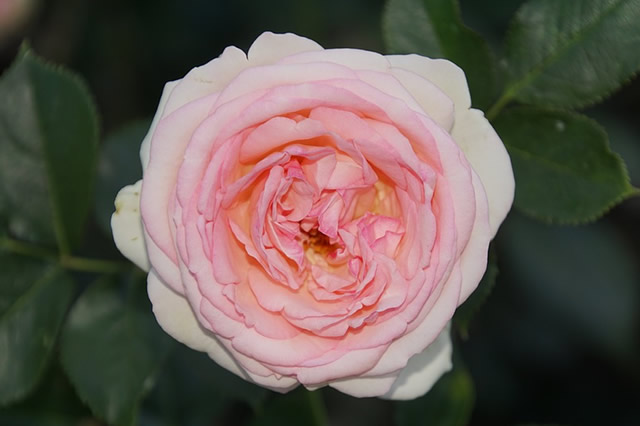
The Dragon Sand Jewel (Rosa ‘Dragon Sand Jewel’) is a captivating modern climbing rose variety, renowned for its elegant blooms in soft white to delicate pink hues. This cultivar is distinguished by its attractive, full-petaled flower shape and vigorous growth habit, making it a popular choice among rose enthusiasts and landscapers alike.
One of the most notable characteristics of the Dragon Sand Jewel is its exceptional flowering performance. When properly cultivated, a single mature plant can produce an astonishing display of over three to four hundred blooms, creating a breathtaking visual spectacle. This prolific blooming capacity makes it an excellent choice for various landscape applications.
The versatility of the Dragon Sand Jewel is evident in its adaptability to different growing methods. It can be effectively trained as a potted specimen to form impressive floral columns, ideal for patios or balconies. Alternatively, when planted in the ground, it excels in creating expansive flower walls or romantic garden arches, showcasing its climbing nature to full effect.
While the Dragon Sand Jewel boasts many positive attributes, it’s worth noting that its blooming period is relatively concentrated compared to some reblooming rose varieties. This characteristic means that while the floral display is spectacular, it may be shorter in duration than some gardeners might prefer. However, with proper care and deadheading, a second, albeit less prolific, bloom can often be encouraged later in the season.
The Dragon Sand Jewel’s exceptional qualities were internationally recognized when it was awarded the prestigious World Rose title at the 2006 World Rose Convention held in Osaka, Japan. This accolade is particularly significant, as it has been bestowed upon only eleven rose varieties worldwide, underscoring the Dragon Sand Jewel’s outstanding attributes and global appeal.
To maximize the performance of the Dragon Sand Jewel, it’s recommended to plant it in a location that receives full sun (at least 6 hours of direct sunlight daily) and in well-draining, fertile soil. Regular feeding during the growing season, consistent watering, and annual pruning will help maintain its vigor and promote abundant flowering. Additionally, providing proper support structures such as trellises or sturdy fences is crucial for showcasing its climbing potential and creating those impressive floral displays.
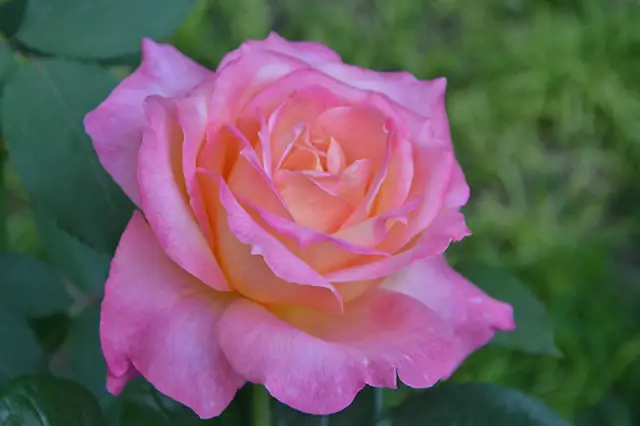
The Colorful Cloud Rose, scientifically known as Rosa ‘Nishiki-gō’ (錦鯉), is a captivating multicolored rose variety that made its debut in Japan in 1980. This cultivar, developed by renowned Japanese rose breeder Seizo Suzuki, is a product of careful hybridization, resulting in a unique floral display that mimics the ethereal beauty of a rainbow.
Each bloom of the Colorful Cloud Rose is a masterpiece of nature’s palette. The petals exhibit a mesmerizing color gradient, starting with a deep, rich pink on the outer surface. As the flower unfurls, the hues intensify and transform, creating a stunning visual effect. The inner petals reveal lighter shades of pink, often blending into soft peach or cream tones. Perhaps the most striking feature is the golden yellow underside of the petals, which adds a warm, luminous quality to the overall appearance.
This rose variety is not just visually appealing but also boasts impressive horticultural qualities. It’s characterized by its vigorous growth habit and abundant flowering. The blooms are notably large, often reaching 3-4 inches (7.5-10 cm) in diameter, and are borne in clusters, creating a lush, bountiful display throughout the growing season.
One of the Colorful Cloud Rose’s most valuable attributes is its robust nature. It demonstrates excellent resistance to common rose diseases such as black spot and powdery mildew, making it a low-maintenance option for both novice and experienced gardeners. This resilience is particularly beneficial in humid climates where fungal diseases can be problematic.
The plant’s tolerance to pruning is another advantageous trait. This characteristic allows gardeners to shape the bush as desired and encourage repeat blooming throughout the season. Regular deadheading and pruning can promote continuous flower production from late spring through early fall.
Given its compact growth habit, typically reaching a height and spread of 3-4 feet (0.9-1.2 meters), the Colorful Cloud Rose is ideally suited for cultivation in smaller spaces. It thrives in containers on balconies or patios, making it an excellent choice for urban gardeners. In larger landscapes, it can be used effectively in mixed borders, as a low hedge, or as a standalone specimen in courtyard gardens.
For optimal growth, plant the Colorful Cloud Rose in a location that receives full sun to partial shade, ensuring at least 6 hours of direct sunlight daily. It prefers well-draining, fertile soil rich in organic matter. Regular feeding with a balanced rose fertilizer during the growing season will support healthy growth and abundant flowering.
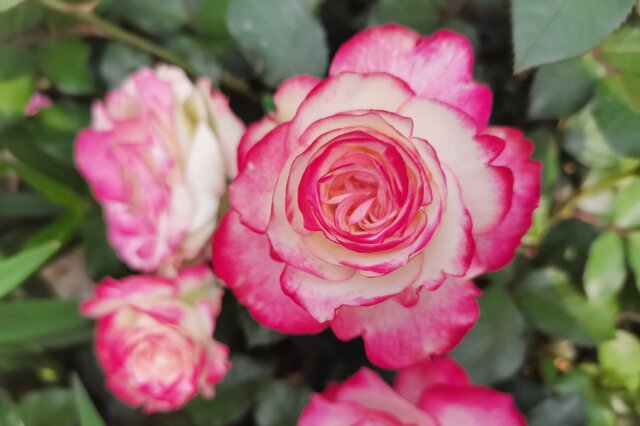
Also known as Cherry Parfait or Fire and Ice, the Duke of Monaco is a floribunda rose variety jointly bred by French breeder Alain Meilland and his sister, Michèle Meilland-Richardier.
This exceptional rose won the prestigious All-America Rose Selections (AARS) award in 2003 and has since remained a timeless classic in the world of roses.
The Duke of Monaco is renowned for its striking bicolor flowers, which are primarily white or pale ivory with a distinctive cherry-red edging. Each bloom measures approximately 3.5 inches (9 cm) in diameter and consists of 25 to 30 petals arranged in a classic hybrid tea form. The flowers appear in clusters, typical of floribunda roses, providing a continuous display throughout the growing season.
This rose variety exhibits a compact, bushy growth habit, reaching a height of 3 to 4 feet (90-120 cm) with a similar spread. Its glossy, dark green foliage provides an attractive backdrop for the vibrant blooms and demonstrates good resistance to common rose diseases such as black spot and powdery mildew.
The Duke of Monaco’s unique coloration is particularly eye-catching, especially when the sun illuminates the petals, creating a luminous effect that enhances its ornamental value in garden settings. This versatility makes it an excellent choice for borders, hedges, or as a standalone specimen in rose gardens.
In addition to its visual appeal, the Duke of Monaco offers a mild, pleasant fragrance, adding another dimension to its charm. Its hardiness (typically zones 5-9) and relatively low maintenance requirements have contributed to its enduring popularity among both novice and experienced rose enthusiasts.
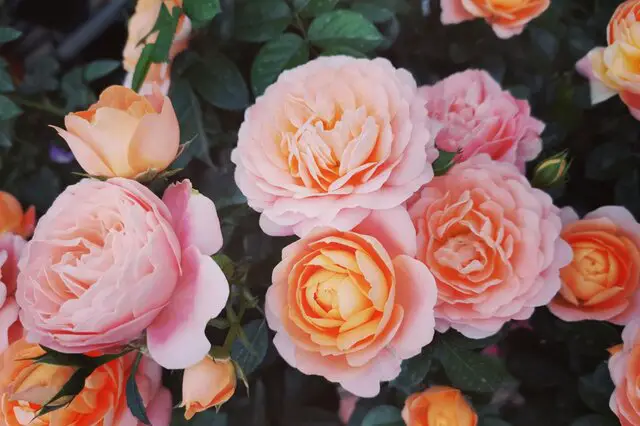
The Juice Terrace rose captivates with its vibrant orange-yellow blooms, reminiscent of freshly squeezed orange juice. This miniature rose variety belongs to the Rosa genus and is a cultivar specifically bred for its compact size and prolific flowering.
Mature Juice Terrace plants typically reach a height of only 50 cm (about 20 inches), making them ideal for indoor cultivation, balconies, and small garden spaces. Their diminutive stature allows for versatile placement in containers, hanging baskets, or as border plants in larger landscapes.
The blooms of the Juice Terrace rose measure 6-8 cm (2.4-3.1 inches) in diameter, featuring a classic rosette form with multiple layers of petals. An interesting characteristic of this variety is its thermochromic nature – the flower color responds to temperature fluctuations. In warmer conditions, the blooms tend to display a lighter hue, while cooler temperatures may intensify the orange tones.
This rose variety is known for its floriferous nature, producing an abundance of blooms throughout its growing season. The prolific flowering, combined with its eye-catching color, contributes to its high ornamental value and popularity in the flower market.
Juice Terrace roses are relatively low-maintenance compared to larger rose varieties. They thrive in well-drained, fertile soil and require at least 6 hours of direct sunlight daily. Regular deadheading (removal of spent blooms) encourages continuous flowering and maintains the plant’s compact shape.
As with many miniature roses, Juice Terrace is well-suited for both outdoor and indoor cultivation, provided it receives adequate light and care. Its compact size and abundant blooms make it an excellent choice for novice gardeners or those with limited space, offering the beauty and fragrance of roses in a manageable package.
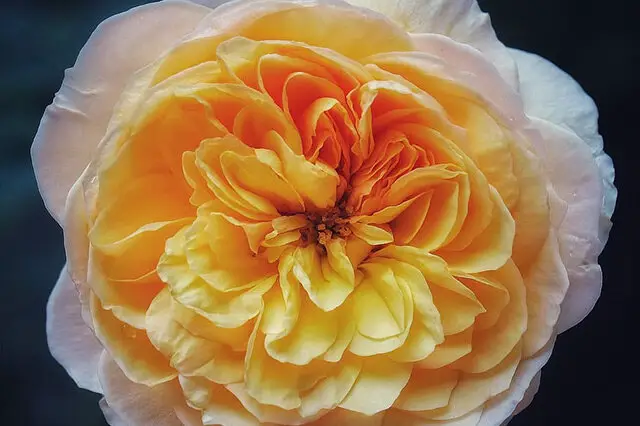
Juliet is a groundbreaking rose variety, renowned for its exceptionally full and spherical flower form. Developed by David Austin, it holds the distinction of being his first cut rose cultivar, earning the moniker “the three million pound rose” due to its lengthy and costly development process.
The color of Juliet is truly unique, exhibiting a soft champagne hue that subtly shifts with environmental conditions. In cooler temperatures, the outer petals take on a delicate blush pink tint, adding to its charm. This color gradient contributes to the rose’s versatility in various floral arrangements.
Juliet’s petals are notably robust, a characteristic that contributes to its excellent vase life as a cut flower. The blooming period is extended, allowing for prolonged enjoyment whether in the garden or in floral displays. The rose reaches its aesthetic pinnacle when it is approximately 70-80% open, showcasing a perfect balance between bud and full bloom.
At full maturity, Juliet’s bloom transforms into an elegant, shallow cup or dish shape. This open form reveals the intricate arrangement of inner petals, creating a different but equally captivating appearance. The transition from bud to full bloom offers a constantly evolving display of beauty.
Juliet’s combination of unique coloration, sturdy petals, long-lasting blooms, and evolving flower shape has made it a favorite among both professional florists and home gardeners. Its ability to blend vintage charm with modern resilience epitomizes the goals of David Austin’s breeding program.
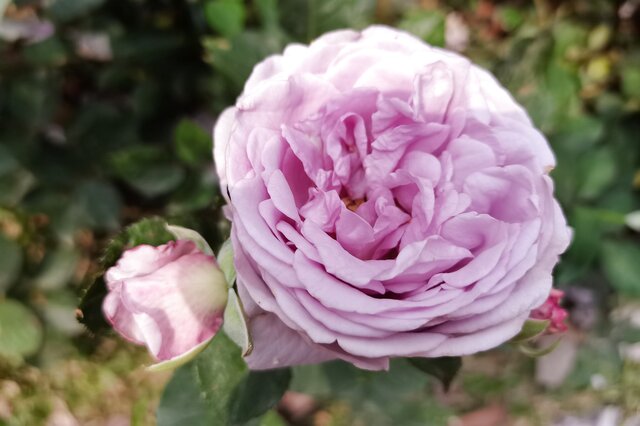
Blue Storm is a luxuriant rose variety endorsed by Kyoto Botanical Gardens in Japan, also known as “Unrequited Love” (相思雨) in Chinese. This cultivar is renowned for its unique coloration and captivating fragrance.
The flowers of Blue Storm are impressively large, featuring a moderate petal count of 25-30 per bloom. This arrangement creates a semi-double flower form, striking a balance between fullness and elegance. The bloom structure is characterized by a graceful, somewhat loose configuration, only revealing its golden stamens when the flower reaches full maturity.
One of Blue Storm’s most distinctive features is its color-changing ability, influenced by environmental conditions. In cooler temperatures, the petals display a soft, ethereal lavender hue, evoking the tranquil beauty of twilight. As temperatures rise, the flowers undergo a subtle transformation, taking on a delicate pink tinge. This chameleonic quality adds an element of intrigue to the rose, making it a dynamic addition to any garden.
The olfactory profile of Blue Storm is equally noteworthy. It produces a medium-strength fragrance that is best described as a complex, mixed aroma. The scent’s character evolves with the changing seasons, offering gardeners a multisensory experience throughout the year. This variability in fragrance adds depth to the sensory appeal of the rose.
Blue Storm’s unique combination of visual allure and aromatic charm makes it an excellent choice for both ornamental gardens and cut flower arrangements. Its color-changing property and seasonal fragrance variations ensure that this rose variety maintains interest across different climatic conditions, making it a versatile and rewarding choice for rose enthusiasts.
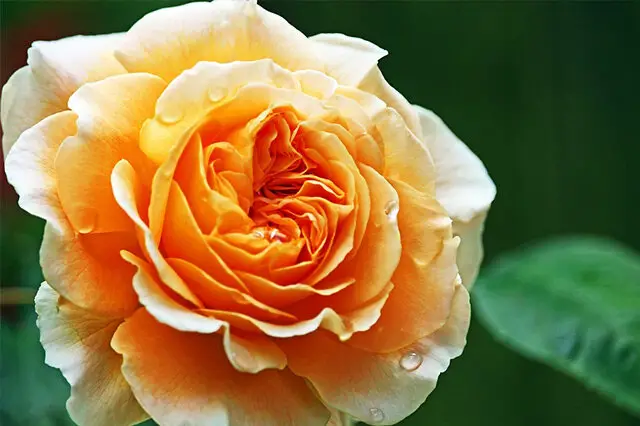
Princess Margaret is a remarkable climbing rose variety meticulously bred by renowned rosarian David Austin. This cultivar is celebrated for its exceptional blooming capacity, gracing gardens with its flowers across multiple seasons, typically from late spring through autumn.
The blooms of Princess Margaret are a captivating apricot-yellow, a color that shifts subtly throughout the flowering period, often deepening to rich amber tones as the flowers mature. Each fully double flower is densely packed with approximately 120 petals, creating a lush, romantic appearance reminiscent of old garden roses. The blooms, measuring about 4 inches (10 cm) in diameter, open from attractive, pointed buds.
While there is a slight resemblance to the Dragon Sand Jewel rose in terms of petal count and fullness, Princess Margaret has its own distinct charm. Its flowers emit a delightful fruity fragrance with notes of citrus and honey, adding another dimension to its appeal.
This rose variety exhibits vigorous growth, capable of reaching heights of 8 to 10 feet (2.4 to 3 meters) with a spread of 4 to 5 feet (1.2 to 1.5 meters). Its glossy, dark green foliage provides an attractive backdrop for the flowers and maintains good disease resistance, a hallmark of many David Austin roses.
Princess Margaret has gained considerable popularity among climbing rose enthusiasts and garden designers alike. Its unique color palette, which is relatively uncommon in climbing roses, combined with its enchanting fragrance and robust growth habit, makes it a prized selection for covering walls, trellises, or arches in both formal and informal garden settings.
For optimal performance, this rose variety thrives in full sun to partial shade and benefits from well-drained, fertile soil. Regular feeding and appropriate pruning will encourage healthy growth and abundant flowering, allowing gardeners to fully appreciate the beauty of Princess Margaret throughout the growing season.
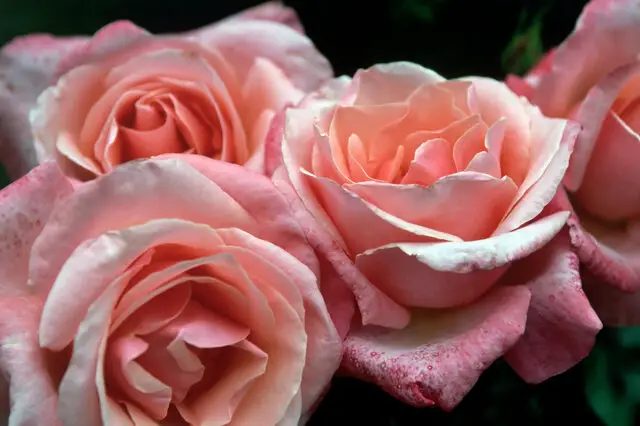
The Silver Jubilee, a distinguished hybrid tea rose variety, was introduced in 1978 to commemorate Queen Elizabeth II’s 25th anniversary on the throne. This robust cultivar, developed by the renowned rosarian Cocker & Sons, typically grows to a height of 1.2 to 1.5 meters (4 to 5 feet) with a spread of about 0.9 meters (3 feet).
The plant produces large, elegantly formed blooms, each measuring 10-12 cm (4-5 inches) in diameter. The flowers exhibit a captivating blend of colors, featuring high-centered, fully double blooms with a warm coral-pink center that gracefully fades to soft salmon-pink towards the outer petals. The reverse of the petals displays a subtle golden-yellow hue, adding depth and complexity to the overall appearance.
These sumptuous blooms are borne singly or in small clusters on long, sturdy stems, making them excellent for cut flower arrangements. The Silver Jubilee rose boasts a strong, pleasing fragrance with distinct notes of lemon, complemented by subtle spicy undertones, enhancing its appeal for both garden and indoor enjoyment.
The foliage of the Silver Jubilee rose is equally impressive, featuring large, glossy, dark green leaves that provide a striking backdrop for the luminous blooms. This rose variety demonstrates good disease resistance, particularly to black spot and rust, making it a relatively low-maintenance choice for rose enthusiasts.
Flowering occurs in flushes throughout the growing season, from late spring to early autumn, ensuring a prolonged display of color and fragrance in the garden. The Silver Jubilee rose thrives in full sun and well-drained, fertile soil, embodying the regal elegance and enduring beauty befitting its commemorative purpose.
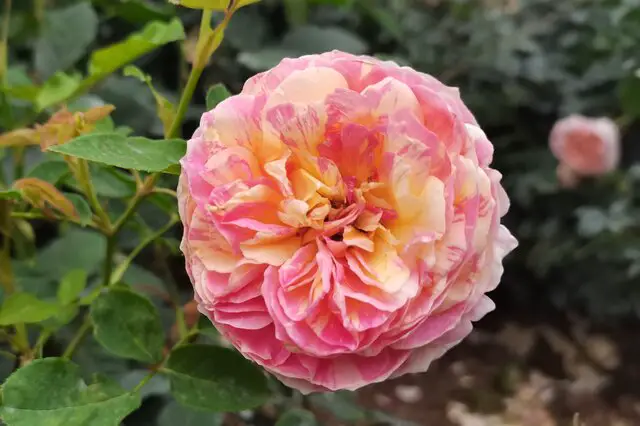
The Monet rose is a captivating cultivar named after the renowned Impressionist painter Claude Monet, developed by the esteemed French rose breeder Delbard. This shrub rose stands out in the garden with its most distinctive feature: a mesmerizing array of striped colors that evoke the artist’s vibrant palette.
When in full bloom, Monet presents a spectacular display of multiple buds opening simultaneously. Each flower is a work of art, boasting densely layered petals that create a lush, peony-like appearance. The blooms are generously sized, typically measuring 3-4 inches (7.5-10 cm) in diameter, and exude a gentle, sweet fragrance.
What truly sets Monet apart from traditional roses is its unique color pattern. Each flower showcases an enchanting blend of pink, yellow, and white hues, reminiscent of Monet’s impressionistic brushstrokes. These colors appear as if delicately painted on the petals, creating an effect that is both striking and subtle. The intensity and distribution of these colors can vary from flower to flower, adding to the rose’s charm and unpredictability.
One of the most fascinating aspects of the Monet rose is its chameleon-like quality. The coloration of the blooms is remarkably responsive to environmental factors, particularly temperature and light intensity. This sensitivity results in an ever-changing display throughout the growing season, earning it the apt nickname “ever-changing Monet.” In cooler temperatures, the colors tend to be more pronounced and vivid, while warmer conditions may produce softer, more blended tones.
Monet is a repeat bloomer, offering continuous flushes of flowers from late spring through fall in most climates. This extended blooming period makes it an excellent choice for gardeners seeking long-lasting color and interest in their landscape. The plant typically grows to a height and spread of 3-4 feet (90-120 cm), making it suitable for both border plantings and as a standalone specimen.
In terms of care, Monet roses prefer full sun exposure and well-draining, fertile soil. They are relatively disease-resistant compared to many other rose varieties, but still benefit from good air circulation to prevent fungal issues. Regular deadheading encourages continuous blooming and maintains the plant’s attractive appearance.
The Monet rose not only serves as a stunning ornamental plant but also makes an excellent cut flower. Its unique coloration and full blooms create captivating floral arrangements that can bring the beauty of Monet’s artistic vision into the home.
In essence, the Monet rose is a living tribute to the artistry of its namesake, offering gardeners and flower enthusiasts a chance to cultivate a piece of Impressionist-inspired beauty in their own landscapes. Its ever-changing nature and striking appearance make it a true masterpiece in the world of roses.
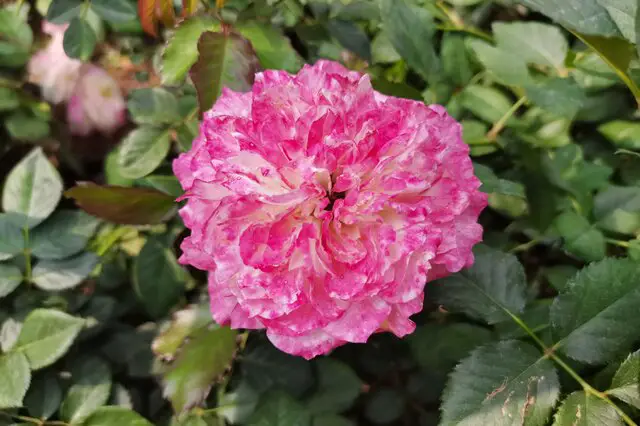
First Makeup is a unique rose cultivar developed through independent breeding efforts in China. This small shrub rose is characterized by its compact stature, vigorous growth habit, and notable disease resistance. Its distinctive beauty and versatile nature make it a popular choice for both landscape use and cut flower arrangements.
The flowers of First Makeup are truly captivating, featuring multicolored petals that create a youthful and dreamy appearance. The blooms exhibit a mesmerizing blend of rouge red and tender milky white hues, reminiscent of a shy young woman applying cosmetics for the first time. The petals are adorned with soft, ruffled edges that contribute to the rose’s ethereal charm.
In terms of fragrance, First Makeup offers a moderate scent profile that evolves over time. Initially, the blooms release a fresh, citrusy aroma dominated by lemon notes. As the flowers mature, this transitions into a delicate rose fragrance, creating a pleasant olfactory experience.
The compact growth habit of First Makeup makes it an excellent choice for small gardens, borders, or container plantings. Its rapid growth rate allows it to establish quickly, while its strong disease resistance reduces the need for chemical interventions, making it suitable for low-maintenance gardens and environmentally conscious gardeners.
As a cut flower, First Makeup excels due to its sturdy stems and long-lasting blooms. The unique coloration and frilled petal edges add texture and interest to floral arrangements, making it a favorite among florists and home gardeners alike.
This rose variety showcases the success of Chinese rose breeding programs in developing cultivars that combine beauty, resilience, and versatility, contributing to the rich tapestry of modern rose cultivation.